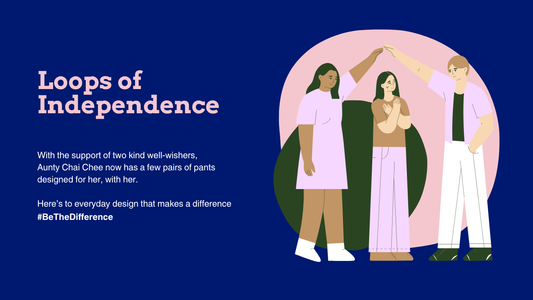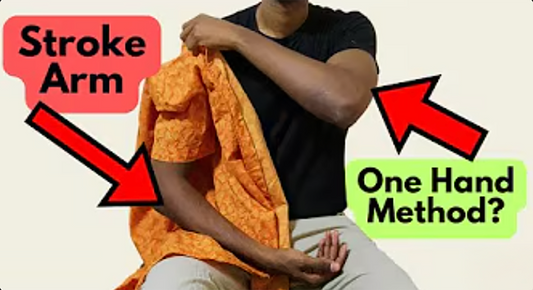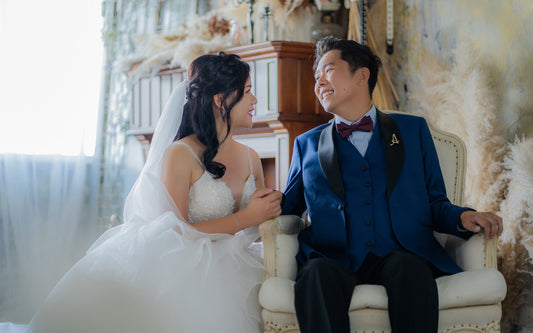
Pioneers of Style | Vogue Singapore
“It’s a task we take for granted—dressing ourselves”: The Singaporean adaptive fashion designers changing the way we dress, design and age
The clothes we wear have yet to catch up with the way we age. In a bid to destigmatise and demystify adaptive fashion, Singapore labels Werable and Will & Well are changing the way we dress and design, one garment at a time.
Buttons. Back zips. Sleeves. These vestimentary details may seem like basic elements of any garment, but for the adaptive fashion community, these are design flaws that lack function and comfort.
Gaining traction only in the last decade, adaptive fashion refers to clothing that accommodates sizings, customisations and fit for wearers with diverse mobility challenges. A large percentage of these consumers comprises the elderly. As it stands, inclusive clothing remains on the fringes of fashion and has yet to break into the collections of mainstream brands and designers.
Notable big-name exceptions include Nike’s FlyEase sneakers, which are hands-free sports shoes that allow wearers of any age and ability to step in and out of; and Tommy Hilfiger Adaptive, which features one-handed zips, magnetic closures, adaptable hems and pieces catered for seated wear. More recently, educator and advocate Sinéad Burke launched Juniper Unlimited, an online marketplace that stocks exclusively adaptive brands.
Globally, past and current conversations on ageism in fashion continue to frame the lack of age diversity as an untapped economic opportunity. Singapore’s fashion scene may be young, but this awareness for the need for more inclusive clothing is well ahead of the curve. Leading the charge are Elisa Lim of Will & Well and Claudia Poh of Werable. For them, good design is driven by empathy, not the economy.
“It always starts from attempting to understand the dressing challenges: their dressing preferences, style preferences and aspirations, down to the kind of fabrics that they like,” Lim says. “After all, the clothes we don are very much part of our identity. How we feel is reflected in what we wear.”
Started in 2017 as part of her graduation collection at LaSalle College of the Arts, Lim founded Will & Well after she was commissioned by a doctor to design clothes for home-care patients. Years on, Will & Well stands as one of Singapore’s most prominent inclusive fashion labels. From hard-to-reach back zips to cumbersome buttons, tackling the practicalities of getting dressed is at the heart of Will & Well’s design ethos.

On Goh Seok La: Will & Well tropical short-sleeved shirt (MagSnap) and unisex drawstring pants (FrontSlit); Kenneth Jay Lane pave and pearl clip earrings from Pedder on Scotts.
“You shouldn’t need yoga flexibility or a pianist’s finger co-ordination to wear good clothing,” reads a line in the Will & Well manifesto. In another, ‘Challenge why clothes are the way they are, especially if they were designed a century ago’. Indeed, if clothes haven’t evolved to meet diverse bodies and abilities, why hasn’t fashion design caught up?
“It’s natural to experience reduced dexterity with age and the elderly experience heightened versions of the same challenges that we all encounter,” says Poh. “It’s a design flaw that causes discomfort but it doesn’t render the garment unwearable. I think that’s why it goes undetected.”
Poh graduated from Parsons School of Design as 2018’s Designer of the Year for Social Innovation, having co-founded Cair Collective, another inclusive design project that ran during her time in New York City. Now at the helm of the newly founded Werable, Poh harnesses fashion design and technology to design wearable products for people of all abilities.
“Adaptive fashion isn’t just bespoke solutions for a niche market. We need our clothes to not only be healthier for our bodies, but for them to grow with us as we enter different phases of our lives.”
One of Werable’s trousers was inspired by the nifty mechanics of origami and onigiri packaging. Similar to the way you would peel off the tabs on a wrapped onigiri, these cotton twill pants unravel to wrap around the wearer instead of having to overly bend one’s knees. By folding and wrapping instead of how one might usually wear a pair of trousers, caregivers are able to put them on without having to lift their care recipient. It’s all in the details—the pants fasten with a magnetic buckle that slides off with close to little effort, while hidden zippers and snap buttons take the place of normally restrictive seams.
The sensitivity required to design inclusively may seem daunting, but the modifications that differentiate these clothes from straight-sized clothing are surprisingly simple. The buttons on a Will & Well shirt, for instance, may be replaced with magnetic ones instead, while drawstring waists take the place of form-fitting zips to allow for greater ease of wear and movement. Poh adds that even an additional loop in the base of a pant leg can help ease the process of taking it off.

On Goh Lusi (left): Werable poplin and Tencel Lyocell ribbed knit shirt, cotton twill trousers; Joomi Lim layered pearl hoop and crystal necklace from Pedder on Scotts. On Goh Liansi (right): Werable ribbed knit and wrinkle-resistant poly crepe top, and cotton twill wide-leg trousers; Oliver Peoples sunglasses.
For Goh Lusi, a client of Werable, the challenges of straight-sized clothing lie in the amount of time and effort it takes. She cares for her twin sister, Liansi, who is a wheelchair user. “The dressing process takes more time,” Lusi says. “For tops, we’re limited to sleeveless or short-sleeved pieces. Tight-fitting pants are definitely out. We had to change Liansi’s entire wardrobe to rubberised or gathered loose pants.”
The limitations of straight-sized clothing are undeniably steeped in ableism and ageism. Fashion has historically favoured youth over age, adolescence over maturity. Fortunately, the tides seem to be changing. Social media, for one, has been enthusiastically embracing elder style. Cases in point: the endless sartorial inspiration supplied by the accounts @gramparents and @elderswithstyle. On the runway, the likes of Simone Rocha, Balenciaga and Eckhaus Latta have frequently cast models above 65. In December, Ikea Singapore dropped its first merchandise collection, Efterträda. The faces of its campaign included the aunties and uncles we know and love, posing in slouchy hoodies one might spot on any street-style set.
But as crucial as age-diverse representation is, much of fashion design remains exclusionary to people with mobility difficulties. The obstacles to normalising inclusive clothing are manifold and go beyond outdated garment closures and hard-to-wear silhouettes. Some elderly wearers remain resistant to the idea of adaptive garments.
“From the very beginning, there has been a resistance towards adaptive clothing,” says Shamla Ramasamy, founder of Purple Threads, Singapore’s first provider of adaptive wear. The lawyer-turned-teacher pioneered the adaptive fashion space in Singapore in 2010, having been one of the first to knock on the doors of hospitals and nursing homes with clothing specially designed with elderly needs in mind.
“It’s a task we take for granted—dressing ourselves,” Ramasamy says. “For the elderly, it gives them a sense of independence and pride.” Having worked with the elderly and people with disabilities for close to a decade now, she notes her own shift in mindset. “I realised I came at it from more of a compassionate approach as opposed to an empathetic approach,” she adds. “Now I know the difference.”
“When we can be more inclusive, our designs will change; the way we approach our consumers will change; everything will change, honestly.”
“It’s so much more than dressing. I learnt that being able to dress someone else quickly and easily is only a fraction of the challenge,” Poh observes. “Sometimes the emotional challenges are tied to independence and agency. It becomes overwhelming.”
Dressed in Werable’s all-cream ensemble alongside her sister, Lusi tells me she feels elegant. “Dressing up has become an enjoyable experience again. Even though Liansi suffered from a stroke, she still wants to look her best and to look feminine.”
Both Will & Well and Werable’s pieces are indistinguishable from straight-sized clothing—and it’s by design. “There are very few options out there that factor in ease of wear,” Poh says. “The alternative is to just buy a few sizes up. The trade-off is wearing something that you don’t feel confident or comfortable in.” Werable’s pieces are reminiscent of any tailoring-centric brand, à la the chops of Christophe Lemaire or Jil Sander, but thoughtfully re-innovated.
For designers, there is the fear of getting it wrong and the illusion that adaptive clothes require more work than a new capsule collection. But as Lim and Poh elucidate, inclusive fashion design is often as simple as an additional seam, replacing buttons and rethinking zipper placement. In the spirit of demystifying such design solutions, Will & Well holds Sew Simple workshops, where Lim and her team impart their technical knowhow on how to refashion existing clothes with adaptive elements such as MagSnap and FrontZip.
Data and technology are an integral part of the equation to push inclusive clothing from niche to mainstream, too. “Adaptive fashion isn’t just bespoke solutions for a niche market,” Poh adds. “We need our clothes to not only be healthier for our bodies, but for them to grow with us as we enter different phases of our lives.”
In an industry that has largely lost sight of what clothes can and should do—to lift and empower through what we choose from our wardrobes each day—inclusive fashion represents an oasis that places its wearers’ wants and needs first. With the likes of Werable and Will & Well here to stay, Lim is hopeful. “When we can be more inclusive, our designs will change; the way we approach our consumers will change; everything will change, honestly.”
Photographer: Grace Ho
Fashion director: Desmond Lim
Make-up: Dollei Seah and Zhou Aiyi / Makeup Entourage using Clarins
Photographer’s assistant: Cordelia Yeo
Styling assistant: Cheryl Tan
Models: Goh Seok La, Goh Liansi, Goh Lusi



